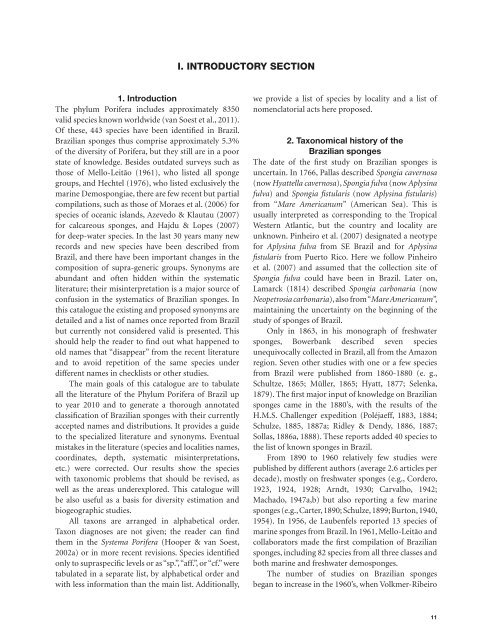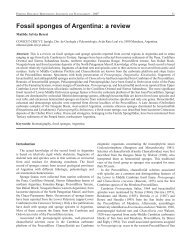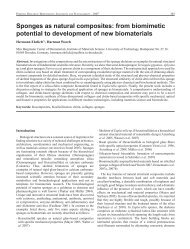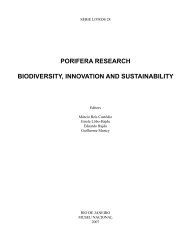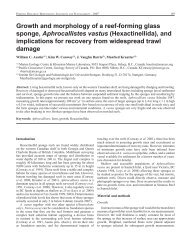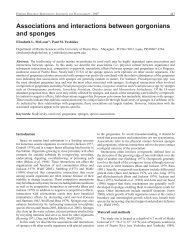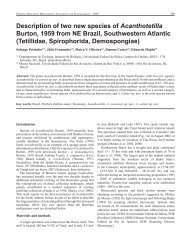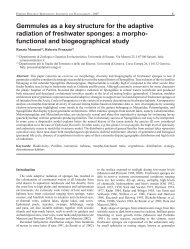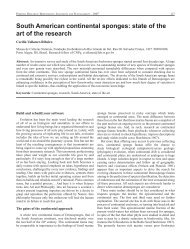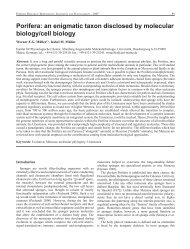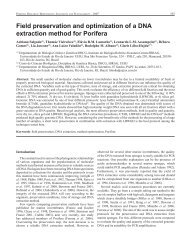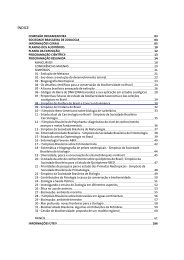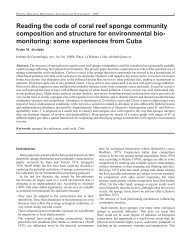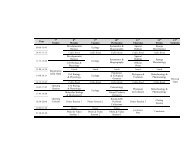I. Introductory Section1. IntroductionThe phylum <strong>Porifera</strong> includes approximately 8350valid species known worldwide (van Soest et al., 2011).Of these, 443 species have been identified in Brazil.<strong>Brazilian</strong> sponges thus comprise approximately 5.3%<strong>of</strong> the diversity <strong>of</strong> <strong>Porifera</strong>, but they still are in a poorstate <strong>of</strong> knowledge. Besides outdated surveys such asthose <strong>of</strong> Mello-Leitão (1961), who listed all spongegroups, and Hechtel (1976), who listed exclusively themarine Demospongiae, there are few recent but partialcompilations, such as those <strong>of</strong> Moraes et al. (2006) forspecies <strong>of</strong> oceanic islands, Azevedo & Klautau (2007)for calcareous sponges, and Hajdu & Lopes (2007)for deep-water species. In the last 30 years many newrecords and new species have been described fromBrazil, and there have been important changes in thecomposition <strong>of</strong> supra-generic groups. Synonyms areabundant and <strong>of</strong>ten hidden within the systematicliterature; their misinterpretation is a major source <strong>of</strong>confusion in the systematics <strong>of</strong> <strong>Brazilian</strong> sponges. Inthis catalogue the existing and proposed synonyms aredetailed and a list <strong>of</strong> names once reported from Brazilbut currently not considered valid is presented. Thisshould help the reader to find out what happened toold names that “disappear” from the recent literatureand to avoid repetition <strong>of</strong> the same species underdifferent names in checklists or other studies.The main goals <strong>of</strong> this catalogue are to tabulateall the literature <strong>of</strong> the Phylum <strong>Porifera</strong> <strong>of</strong> Brazil upto year 2010 and to generate a thorough annotatedclassification <strong>of</strong> <strong>Brazilian</strong> sponges with their currentlyaccepted names and distributions. It provides a guideto the specialized literature and synonyms. Eventualmistakes in the literature (species and localities names,coordinates, depth, systematic misinterpretations,etc.) were corrected. Our results show the specieswith taxonomic problems that should be revised, aswell as the areas underexplored. This catalogue willbe also useful as a basis for diversity estimation andbiogeographic studies.All taxons are arranged in alphabetical order.Taxon diagnoses are not given; the reader can findthem in the Systema <strong>Porifera</strong> (Hooper & van Soest,2002a) or in more recent revisions. Species identifiedonly to supraspecific levels or as “sp.”, “aff.”, or “cf.” weretabulated in a separate list, by alphabetical order andwith less information than the main list. Additionally,we provide a list <strong>of</strong> species by locality and a list <strong>of</strong>nomenclatorial acts here proposed.2. Taxonomical history <strong>of</strong> the<strong>Brazilian</strong> spongesThe date <strong>of</strong> the first study on <strong>Brazilian</strong> sponges isuncertain. In 1766, Pallas described Spongia cavernosa(now Hyattella cavernosa), Spongia fulva (now Aplysinafulva) and Spongia fistularis (now Aplysina fistularis)from “Mare Americanum” (American Sea). This isusually interpreted as corresponding to the TropicalWestern Atlantic, but the country and locality areunknown. Pinheiro et al. (2007) designated a neotypefor Aplysina fulva from SE Brazil and for Aplysinafistularis from Puerto Rico. Here we follow Pinheiroet al. (2007) and assumed that the collection site <strong>of</strong>Spongia fulva could have been in Brazil. Later on,Lamarck (1814) described Spongia carbonaria (nowNeopetrosia carbonaria), also from “Mare Americanum”,maintaining the uncertainty on the beginning <strong>of</strong> thestudy <strong>of</strong> sponges <strong>of</strong> Brazil.Only in 1863, in his monograph <strong>of</strong> freshwatersponges, Bowerbank described seven speciesunequivocally collected in Brazil, all from the Amazonregion. Seven other studies with one or a few speciesfrom Brazil were published from 1860-1880 (e. g.,Schultze, 1865; Müller, 1865; Hyatt, 1877; Selenka,1879). The first major input <strong>of</strong> knowledge on <strong>Brazilian</strong>sponges came in the 1880’s, with the results <strong>of</strong> theH.M.S. Challenger expedition (Poléjaeff, 1883, 1884;Schulze, 1885, 1887a; Ridley & Dendy, 1886, 1887;Sollas, 1886a, 1888). These reports added 40 species tothe list <strong>of</strong> known sponges in Brazil.From 1890 to 1960 relatively few studies werepublished by different authors (average 2.6 articles perdecade), mostly on freshwater sponges (e.g., Cordero,1923, 1924, 1928; Arndt, 1930; Carvalho, 1942;Machado, 1947a,b) but also reporting a few marinesponges (e.g., Carter, 1890; Schulze, 1899; Burton, 1940,1954). In 1956, de Laubenfels reported 13 species <strong>of</strong>marine sponges from Brazil. In 1961, Mello-Leitão andcollaborators made the first compilation <strong>of</strong> <strong>Brazilian</strong>sponges, including 82 species from all three classes andboth marine and freshwater demosponges.The number <strong>of</strong> studies on <strong>Brazilian</strong> spongesbegan to increase in the 1960’s, when Volkmer-Ribeiro11
<strong>Catalogue</strong> <strong>of</strong> <strong>Brazilian</strong> <strong>Porifera</strong>started her studies on <strong>Brazilian</strong> sponges (Fig. 1). Shepublished since then more than 130 studies includingarticles, book chapters, and conference proceedingsfrom 1963 to 2010, representing a major contributionto the knowledge <strong>of</strong> <strong>Brazilian</strong> sponges, especially <strong>of</strong>freshwater. From 1960 to 1969, a total <strong>of</strong> 10 studieswere published on <strong>Brazilian</strong> sponges (e.g., Mello-Leitão et al., 1961; Volkmer, 1963a, b; Volkmer-Ribeiro,1969; Fig. 1).In the 1970’s there was an increase in the number<strong>of</strong> articles (34) and <strong>of</strong> authors publishing on <strong>Brazilian</strong>sponges. The studies <strong>of</strong> Borojevic (1971) and Borojevic& Peixinho (1976) on calcareous sponges, Volkmer-Ribeiro & de Rosa-Barbosa (1972, 1974, 1978), deRosa-Barbosa (1979) and Bonetto & Ezcurra de Drago(1973) on freshwater sponges, and those <strong>of</strong> Johnson(1971), Collette & Rützler (1977), Mello-Leitão &Pacheco-Coelho (1978), Maggs et al. (1979) andespecially <strong>of</strong> Mothes de Moraes (e.g., Volkmer-Ribeiro& Mothes de Moraes, 1975; Mothes de Moraes, 1977,1978) on marine Demospongiae greatly increased thetaxonomic knowledge <strong>of</strong> <strong>Brazilian</strong> sponges. However,these studies were limited to relatively few taxonomicgroups or geographic areas. The main contribution tothe taxonomy <strong>of</strong> <strong>Brazilian</strong> <strong>Porifera</strong> in this decade wasthe description <strong>of</strong> 60 species <strong>of</strong> marine demospongescollected by the Calypso expedition all along theEastern <strong>Brazilian</strong> coast, from Fernando de NoronhaArchipelago to Rio Grande do Sul State (Boury-Esnault, 1973).The 1970’s also witnessed an increase in thenumber <strong>of</strong> research approaches, which were untilthen limited to taxonomy and faunistics. The firststudies on the ecology <strong>of</strong> sponges in Brazil were those<strong>of</strong> B<strong>of</strong>fi (1972) reporting ophiuroids associated tomarine sponges and <strong>of</strong> Volkmer-Ribeiro & de Rosa-Barbosa (1972, 1974) on sponge-sponge and molluskfreshwatersponge associations. The first studies onsponge chemistry and evolution were published by theend <strong>of</strong> the decade (Kelecom & Kannengiesser, 1979;Volkmer-Ribeiro, 1979). In the first zoogeographicalanalysis <strong>of</strong> <strong>Brazilian</strong> sponges, Hechtel (1976) listed 156marine demosponges occurring in Brazil.The trend <strong>of</strong> increase in authors and areas <strong>of</strong>knowledge <strong>of</strong> studies on <strong>Brazilian</strong> sponges persistedand gained impulse in the 1980’s (30 articles). Themain contributions to the taxonomy were those <strong>of</strong> Solé-Cava et al. (1981), Hechtel (1983), Volkmer-Ribeiro(1984, 1986), Volkmer-Ribeiro et al. (1981, 1983, 1984,1988) and Mothes de Moraes (1980, 1981, 1983, 1985a,b, 1987). More ecological studies were published thanin the previous decades, focusing on fish predation(Volkmer-Ribeiro & Grosser, 1981), associated fauna(Duarte & Morgado, 1983), vertical distribution (Estonet al., 1986) and pollution-biomonitoring (Muricy,1989). The first pharmacological study <strong>of</strong> a <strong>Brazilian</strong>sponge was published by the end <strong>of</strong> the decade (Attaet al., 1989; Fig. 2).In the 1990’s, there was a two-fold increase in thenumber <strong>of</strong> studies published (from 30 to 72 articles; Fig.1). The number <strong>of</strong> authors and <strong>of</strong> areas <strong>of</strong> knowledgealso increased. In this decade were published the firststudies on genetics using both allozyme electrophoresis(Solé-Cava et al., 1991; Klautau et al., 1994a, 1999;Lazoski et al., 1999) and DNA analysis (Lôbo-Hajduet al., 1999), cytology (Boury-Esnault et al., 1994a),biochemistry (Zierer et al., 1995), paleontology(Sifeddine et al., 1994; Ferreira & Fernandes, 1997),phylogeny (Hajdu, 1995, 1999), biomass (Melão &Rocha, 1996b), growth rates (Melão & Rocha, 1998),chemical ecology (Epifanio et al., 1999), and larvalbiology (Vacelet, 1999) <strong>of</strong> sponges from Brazil.The exponential growth <strong>of</strong> the literature on<strong>Brazilian</strong> <strong>Porifera</strong> continued from 2000 to 2009,with 250 articles published. New areas <strong>of</strong> knowledgestudied included spiculogenesis (Custódio et al.,2002), bioerosion (Reis & Leão, 2002), bioinvasion(Ferreira et al., 2006), microbiology (Turque et al.,2008; Hardoim et al., 2009; Marinho et al., 2009), DNAsequencing (Cárdenas et al., 2009), and reproduction(Lanna et al., 2007b). All areas previously studied hada great increase in number <strong>of</strong> publications, especiallytaxonomy, chemistry, pharmacology, and ecology. Thestudy <strong>of</strong> <strong>Porifera</strong> in Brazil during the first decade <strong>of</strong> theXXI century was marked by the realization <strong>of</strong> the 7 thInternational Sponge Symposium (7 th ISS) in Armaçãodos Búzios, Rio de Janeiro State, in May 2006. Thisconference had 260 participants from 35 countriesand attracted a great interest from the <strong>Brazilian</strong>scientific community, with 91 <strong>Brazilian</strong> participantsfrom 18 institutions presenting a total <strong>of</strong> 71 abstracts.It is therefore not surprinsing that the year with thehighest number <strong>of</strong> publications in the history <strong>of</strong>spongiology in Brazil so far was 2007 (59 articles),when the proceedings <strong>of</strong> the 7 th ISS were published(Fig. 2; Custódio et al., 2007).Another major accomplishment in the decade from2000 to 2009 was the Project REVIZEE, a governmentalprogram aimed at listing and mapping the biologicalresources <strong>of</strong> the <strong>Brazilian</strong> Exclusive Economic Zone(EEZ; e.g., Amaral et al., 2003; Amaral & Rossi-Wongtschowski, 2004; Lavrado & Ignacio, 2006). The12
- Page 4 and 5: CATALOGUE OFBRAZILIAN PORIFERAGUILH
- Page 6 and 7: SUMMARYAbstract ...................
- Page 8: ABSTRACTAll the literature (486 ref
- Page 14 and 15: Introductory SectionArticles per De
- Page 16: Introductory SectionRRAPAMPAMACERNA
- Page 19 and 20: Catalogue of Brazilian PoriferaPori
- Page 21 and 22: Catalogue of Brazilian Poriferaof a
- Page 23 and 24: Catalogue of Brazilian PoriferaSUNY
- Page 26 and 27: II. TAXONOMIC LISTPHYLUM PORIFERA G
- Page 28 and 29: Taxonomic ListTYPE LOCALITY: Brazil
- Page 30 and 31: Taxonomic ListREMARKS: The specimen
- Page 32 and 33: Taxonomic ListTYPE LOCALITY: Easter
- Page 34 and 35: Taxonomic ListJapan, and Brazil. Th
- Page 36 and 37: Taxonomic List[description]; Mello-
- Page 38 and 39: Taxonomic List& Peixinho, 1976 [des
- Page 40 and 41: Taxonomic List1999 [faunistics]; Ha
- Page 42 and 43: Taxonomic ListState: Atol das Rocas
- Page 44 and 45: Taxonomic ListK Stelletta crassispi
- Page 46 and 47: Taxonomic ListK Erylus corneus Bour
- Page 48 and 49: Taxonomic List[diagnosis]). Off San
- Page 50 and 51: Taxonomic Listdescription]; Sollas,
- Page 52 and 53: Taxonomic ListP Dercitus (Stoeba) S
- Page 54 and 55: Taxonomic List63; Amaral et al., 20
- Page 56 and 57: Taxonomic ListKlautau et al., 1994b
- Page 58 and 59: Taxonomic ListDysidea fragilis sens
- Page 60 and 61: Taxonomic ListTYPE LOCALITY: Eritre
- Page 62 and 63:
Taxonomic List(REVIZEE sta. C5-2R,
- Page 64 and 65:
Taxonomic ListH.M.S. Challenger cre
- Page 66 and 67:
Taxonomic ListCliona carteri, Hecht
- Page 68 and 69:
Taxonomic Liststate: Guarapari (20
- Page 70 and 71:
Taxonomic ListFinali, 1993: 274; R
- Page 72 and 73:
Taxonomic ListChondrilla phyllodes
- Page 74 and 75:
Plates
- Page 76 and 77:
Taxonomic ListFig. 6. Type specimen
- Page 78 and 79:
Taxonomic ListFig. 8. Type specimen
- Page 80 and 81:
Taxonomic ListFig. 10. Type and rep
- Page 82 and 83:
Taxonomic ListFig. 12. Type specime
- Page 84 and 85:
Taxonomic ListFig. 14. Type specime
- Page 86 and 87:
Taxonomic List1973 [description]; H
- Page 88 and 89:
Taxonomic ListSão Paulo State: Sã
- Page 90 and 91:
Taxonomic ListE Axinella Schmidt, 1
- Page 92 and 93:
Taxonomic ListTYPE LOCALITY: Brazil
- Page 94 and 95:
Taxonomic ListTYPE SPECIMENS: Holot
- Page 96 and 97:
Taxonomic Listthe Lithistida is wid
- Page 98 and 99:
Taxonomic Listet al., 2004b [descri
- Page 100 and 101:
Taxonomic ListCladochalina armigera
- Page 102 and 103:
Taxonomic ListK Chalinula zeae de W
- Page 104 and 105:
Taxonomic List& van Soest, 1998: 91
- Page 106 and 107:
Taxonomic ListSantos et al., 2002b
- Page 108 and 109:
Taxonomic List1988; Lehnert & van S
- Page 110 and 111:
Taxonomic ListK Oceanapia fistulosa
- Page 112 and 113:
Taxonomic List[description]). ARAGU
- Page 114 and 115:
Taxonomic ListState: Caseara, Aragu
- Page 116 and 117:
Taxonomic ListRibeiro & Batista, 20
- Page 118 and 119:
Taxonomic ListK Metania spinata (Ca
- Page 120 and 121:
Taxonomic ListOncosclera navicela,
- Page 122 and 123:
Taxonomic Listdescription]). Manaus
- Page 124 and 125:
Taxonomic List& Pronzato, 2002), Ve
- Page 126 and 127:
Taxonomic ListParaná River (near o
- Page 128 and 129:
Taxonomic List2007b [faunistics]).
- Page 130 and 131:
Taxonomic ListK Heteromeyenia insig
- Page 132 and 133:
Taxonomic ListType species: Heterom
- Page 134 and 135:
Taxonomic Listal., 2003 [faunistics
- Page 136 and 137:
Taxonomic ListWORLD DISTRIBUTION: B
- Page 138 and 139:
Taxonomic ListPará State: Santaré
- Page 140 and 141:
Taxonomic ListRiver (Itaipu H.P.S.;
- Page 142 and 143:
Taxonomic ListMoraes et al., 2006:
- Page 144 and 145:
Taxonomic ListBRAZILIAN RECORDS: So
- Page 146 and 147:
Taxonomic Listfrom those presented
- Page 148 and 149:
Taxonomic ListFortaleza (Johnson, 1
- Page 150 and 151:
Taxonomic ListTYPE SPECIMENS: Holot
- Page 152 and 153:
Taxonomic ListState: Off Guarujá (
- Page 154 and 155:
Taxonomic ListFamily Guitarridae De
- Page 156 and 157:
Taxonomic ListSchizolectotypes USNM
- Page 158 and 159:
Taxonomic List1994: 569; Hajdu, 199
- Page 160 and 161:
Taxonomic ListSuborder Myxillina Ha
- Page 162 and 163:
Taxonomic ListTYPE SPECIMENS: Synty
- Page 164 and 165:
Taxonomic ListWORLD DISTRIBUTION: C
- Page 166 and 167:
Taxonomic List1998: 88; Muricy & Si
- Page 168 and 169:
Taxonomic ListHajdu & Lopes, 2007:
- Page 170 and 171:
Taxonomic Listal., 2006: 166; Cedro
- Page 172 and 173:
Taxonomic ListWORLD DISTRIBUTION: E
- Page 174 and 175:
Taxonomic Listal., 2008 [pharmacolo
- Page 176 and 177:
Taxonomic List(Amapá or Pará (Col
- Page 178 and 179:
Taxonomic ListRegion: Espírito San
- Page 180 and 181:
Taxonomic ListP Hyalonema (Cylicone
- Page 182 and 183:
Taxonomic ListC2-20F (off Linhares,
- Page 184 and 185:
Taxonomic ListFor synonyms see Taba
- Page 186 and 187:
Records Identified Only to Genus Le
- Page 188 and 189:
Records Identified Only to Genus Le
- Page 190 and 191:
Records Identified Only to Genus Le
- Page 192 and 193:
Records Identified Only to Genus Le
- Page 194 and 195:
Records Identified Only to Genus Le
- Page 196 and 197:
Records Identified Only to Genus Le
- Page 198 and 199:
Records Identified Only to Genus Le
- Page 200 and 201:
Records Identified Only to Genus Le
- Page 202 and 203:
IV. LIST OF NOMENCLATORIAL ACTSA sy
- Page 204 and 205:
List of Nomenclatorial ActsHaliclon
- Page 206 and 207:
V. SPECIES NAMES PREVIOUSLY REPORTE
- Page 208 and 209:
Species Names Previously Reported F
- Page 210 and 211:
Species Names Previously Reported F
- Page 212 and 213:
Species Names Previously Reported F
- Page 214 and 215:
Species Names Previously Reported F
- Page 216 and 217:
Species Names Previously Reported F
- Page 218 and 219:
VI. LIST OF SPECIES BY LOCALITYThe
- Page 220 and 221:
List of Species by LocalityPottsiel
- Page 222 and 223:
List of Species by Localityfloridan
- Page 224 and 225:
List of Species by LocalityOff São
- Page 226 and 227:
List of Species by LocalityAcarnus
- Page 228 and 229:
List of Species by LocalityJoão Pi
- Page 230 and 231:
List of Species by LocalityHymeniac
- Page 232 and 233:
List of Species by LocalityEunapius
- Page 234 and 235:
VII. Taxonomic IndexThis index incl
- Page 236 and 237:
Taxonomic Indexarmigera, Callyspong
- Page 238 and 239:
Taxonomic Indexcarteri, Craniella .
- Page 240 and 241:
Taxonomic Indexcunctatrix, Spirastr
- Page 242 and 243:
Taxonomic IndexForcepia (Ectoforcep
- Page 244 and 245:
Taxonomic Indexjanusi, Verongia ...
- Page 246 and 247:
Taxonomic Indexmucronata, Myxilla .
- Page 248 and 249:
Taxonomic Indexplumosa var. palmeri
- Page 250 and 251:
Taxonomic Indexschmidti, Cliona ...
- Page 252 and 253:
Taxonomic Indextoxiformis, Erylus .
- Page 254 and 255:
VIII. REFERENCESRemarks: The articl
- Page 256 and 257:
Referencesdo Cabo - RJ. Revista Pes
- Page 258 and 259:
ReferencesDémosponges du plateau c
- Page 260 and 261:
ReferencesCarter, H.J. (1869) On Gr
- Page 262 and 263:
ReferencesSudamericanas. Comunicaci
- Page 264 and 265:
ReferencesDickinson, M.G. (1945) Sp
- Page 266 and 267:
ReferencesPark, Ceará State, Brazi
- Page 268 and 269:
Referencesinvertebrados marinhos da
- Page 270 and 271:
ReferencesHooper, J.N.A. & van Soes
- Page 272 and 273:
ReferencesSouza, A.O., Galetti, F.C
- Page 274 and 275:
ReferencesRaspailia (Raspaxilla) bo
- Page 276 and 277:
Referencesof the West Indies: Disco
- Page 278 and 279:
Referencese futuro. In: Viana, D.L.
- Page 280 and 281:
References*Muricy, G. & Minervino,
- Page 282 and 283:
References(Brazil) (Tetillidae, Spi
- Page 284 and 285:
Referencesfive new species. Zoologi
- Page 286 and 287:
ReferencesRose, C.S. & Risk, M.J. (
- Page 288 and 289:
ReferencesMit Nachträgen zu den Sp
- Page 290 and 291:
ReferencesSystema Porifera: A guide
- Page 292 and 293:
ReferencesSollas, W.J. (1889) On th
- Page 294 and 295:
ReferencesSociété Scientifique et
- Page 296 and 297:
ReferencesBiodiversity, Innovation
- Page 298 and 299:
References*Volkmer-Ribeiro, C. & Ta
- Page 300:
ReferencesWiedenmayer, F. (1977) Sh


